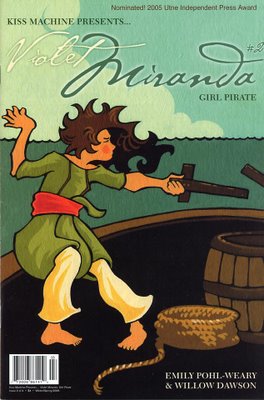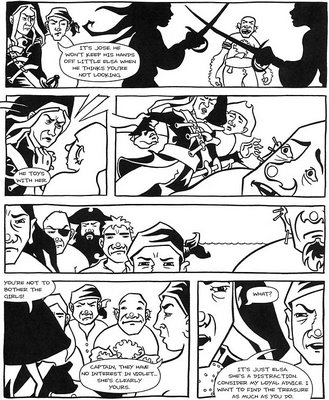Sunday, April 16, 2006
Violet Miranda: Girl Pirate #1-2

Published by Kiss Machine
Written by Emily Pohl-Weary
Illustrated by Willow Dawson
The Kiss Machine website describes this series as a graphic novel being released in four parts, with the creators having "envisioned Violet Miranda: Girl Pirate in response to the male-dominated comics industry's lack of positive role models for teen girls."
The comic is certainly distinctive-looking; Dawson's thick lines produce pages reminiscent of woodblock prints. The writer's choice of time period sets the book apart, too. Like El Cazador, CrossGen's short-lived series by Chuck Dixon and Steve Epting, Violet Miranda is a period piece, taking full advantage of the particularities of setting and characterization that the early eighteenth century affords. And as an adventure title centered upon two early modern female action heroines, this title is indeed refreshingly distinctive.
As in any good yarn, things are set in motion by some unexpected events. When the action begins, Violet Miranda and Elsa Bonnet are in their mid-teens, and have been living a sheltered existence on a small Caribbean island with their parents. It's clear that their paradisical existence is but a sojourn, since their fathers are on the run from someone or something, and live in fear that their hide-away will eventually be discovered.
The men's luck does indeed run out at the close of issue #1, and the island is invaded by a pirate named John, who is the son of the notorious Calico Jack Rackham. Violet and Elsa witness the murder of their fathers at the hands of the vengeance-driven marauder, and the girls and their mothers are taken captive.
John Rackham is written as an ambiguous character: he has killed the girls' fathers in cold blood, yet he forcefully enjoins his men not to molest the defenseless women. (It's no surprise that he is forced to back up the injunction with violence when one of the crew misbehaves.)
Additional ambiguity: we learn that the murdered men were not without blemish. While serving as crewmen under John's father they deserted (and possibly betrayed) him just before he was captured and consigned to the gallows. Prior to absconding, the two acquired a heap of treasure, and got hold of a map promising directions to untold riches. Since Calico Jack was engaged in the search for this self-same treasure prior to his capture, John believes its riches to be his birthright, and he intends to keep hold of the Violet, Elsa, and their mothers until he and his crew find it.
Issue #2 begins several months after the girls have been brought aboard John's ship, and we find that they've grown inured to life at sea. Though not at liberty, they're feeling and acting less like captives than they were at the close of the previous issue. One evening Violet asks John to explain the source of the feud between their fathers, and he complies, providing several capsule flashbacks depicting the colorful story of Calico Jack, and Mary Read and Anne Bonney, the two well-known female pirates.
I found Violet's lack of outward hostility towards the man who killed her father somewhat jarring. However, her stance is considerably tempered by an extended passage in which she recalls the dead man in flashback, with the final panel conveying to the reader that perhaps her public demeanor might not exactly match her inner emotions.

The core action in issue #2 concerns Violet and Elsa's training in sword-fighting; Violet cannily asks John to teach them how to defend themselves, in case the ship should fall into unwelcome hands. Having recently told detailed stories about his own mother's talents with both sword and pistol, John finds himself in no position to refuse the request.
After gaining considerable aptitude with wooden swords, John allows the girls to spar with true blades, and they soon surpass all of the men on board ship save the captain himself. The reader perceives (and indeed, hopes) that the girls might have their own motives, and a private conversation reveals some of their intentions.

Salty dogs, be warned: I would definitely watch out for Elsa.
Although issue #2 is more or less light-heartedly concerned with the girl's training in sword-fighting, there are several serious matters at the heart of things that just won't go away. After all, the story does concern four women being held against their will aboard a pirate ship. (Careful readers will note that Dawson always draws the older female characters with deeply lined and/or sunken eyes that betray their underlying concern over their condition.)
Towards the end of the issue, this is brought to the surface, as one of John's crewmen mentions that although they all recognize that Violet is his, Elsa's presence is inciting the men.

Issue #2 ends with a cliffhanger. The pirates are granted a two-week shore leave, and Elsa is trundled off to stay at the home of a crewman who happens to be a family man. (The other women join them.) Violet, however, is taken to parts unknown by John.
Several questions have been placed on the table:
— Why does John agree to train the girls?
— At one point he cryptically refers to them as his secret weapons; what does he mean?
— Is John a genuine rogue, or does he just work in an occupation that requires intermittent murderous behavior?
Violet Miranda: Girl Pirate joins Polly and the Pirates in ingeniously adding young women to this most durable and enjoyable of genres. I look forward to seeing how the ambiguities and details of this plot are resolved in future issues.
